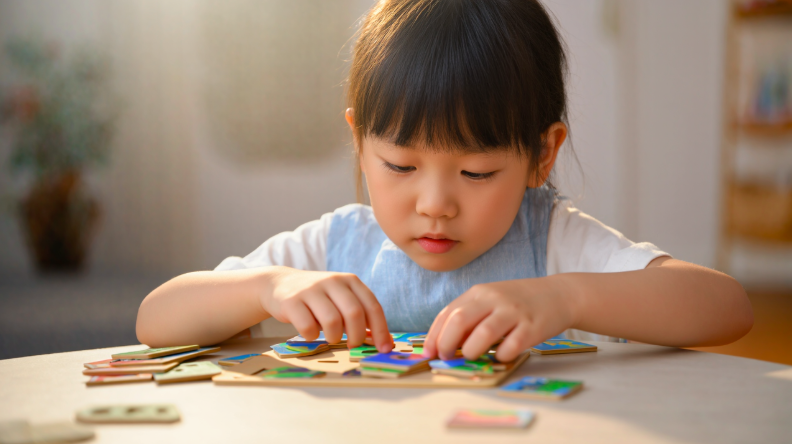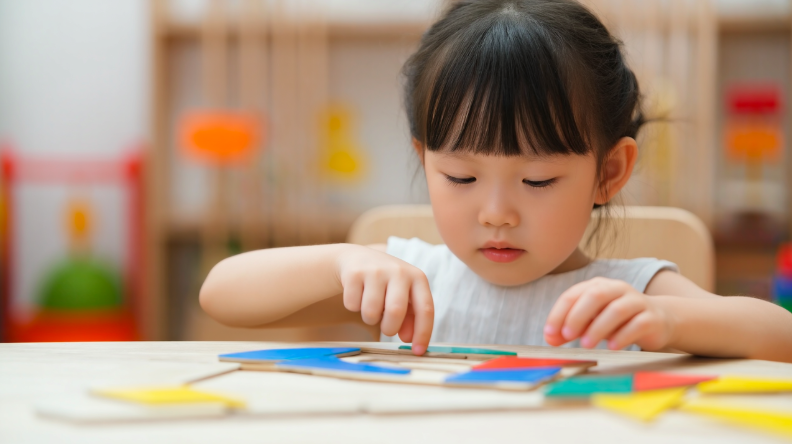What Age Should Kids Start Doing Puzzles? Developmental Milestones
Learn the best age for kids to start puzzles. Find out how puzzles help with cognitive, motor, and problem-solving skills development.
Apr 03, 20256.8K Shares93.4K Views

Puzzles are more than just a fun activity for kids—they play a crucial role in their development. By solving puzzles, children can improve their cognitive skills, motor skills, and problem-solving abilities.
Firstly, puzzles help children with cognitive development. They encourage kids to think critically, recognize patterns, and understand how different pieces fit together. This type of thinking boosts their memory and focus, both of which are essential for learning.
Secondly, puzzles help develop motor skills. As children work with puzzle pieces, they practice hand-eye coordination, fine motor skills, and dexterity. Handling the pieces, turning them, and placing them in the right spots requires precise movements, which strengthens their hand muscles and improves coordination.
Finally, puzzles are excellent for problem-solving skills. Kids learn how to approach a task, try different solutions, and figure out how to complete the puzzle. This encourages them to think creatively and stay persistent until they find the answer.
The Best Age To Start Puzzles: Developmental Milestones
Toddlers (Ages 1-2): Wooden Puzzles
For toddlers, simple wooden puzzles are the best option. At this age, children are still developing their fine motor skills, so large, easy-to-handle pieces are essential. Wooden puzzles with pegs help children practice picking up and placing pieces, which improves their hand-eye coordination and motor skills. Around 18 months, toddlers start to recognize shapes and colors, which is when they can begin solving basic puzzles with two to four pieces.
Preschoolers (Ages 3-4): Basic Jigsaw Puzzles
As children enter the preschool stage, their cognitive skills are growing. They begin to understand the concept of fitting pieces together and can manage puzzles with around 6-12 pieces. At this age, they can also start recognizing patterns and sorting pieces by color and shape. Simple jigsaw puzzles are a great choice for this developmental stage, as they encourage problem-solving and help improve spatial awareness.
School-Age Children (Ages 5-7): Intermediate Jigsaw Puzzles
As children grow older, their problem-solving skills become more advanced. At ages 5-7, children can handle puzzles with more pieces—ranging from 24 to 100. These puzzles require them to think more critically about the image they are creating and develop strategies for fitting the pieces together. They also start to improve their ability to visualize the end result before completing the puzzle. This stage supports the development of patience, focus, and persistence.
Older Children (Ages 8+): Complex Jigsaw Puzzles
For children over the age of 8, puzzles with 100+ pieces are appropriate. These more complex puzzles engage the child's ability to think strategically and logically. At this age, children can manage puzzles with intricate designs, such as landscapes, maps, or famous art pieces. The challenge of completing these puzzles helps children develop executive function skills like planning, organization, and decision-making.
Benefits Of Puzzles For Toddlers And Young Children
Toddlers (Ages 1-3): Improving Fine Motor Skills and Hand-Eye Coordination
For toddlers, puzzles are a fantastic tool for developing fine motor skills. At this stage, children are still mastering basic movements, so puzzles with large pieces and simple shapes are ideal. By placing pieces into their proper spots, toddlers practice using their hands and fingers in precise ways. This helps strengthen hand muscles and improves control over small movements.
Shape-sorting toys and large-piece puzzles are perfect for this age group. These toys encourage toddlers to match shapes and colors, which supports early cognitive development. As toddlers grasp and fit pieces together, they also improve their hand-eye coordination, learning how to guide their hands based on what they see.
Young Children (Ages 3-5): Enhancing Early Problem-Solving and Cognitive Skills
As children grow older, puzzles continue to help with problem-solving abilities. For young children, simple jigsaw puzzles (with 6-12 pieces) encourage them to think about how pieces fit together. They start to recognize patterns and begin understanding cause and effect—if they place a piece in the right spot, the puzzle moves forward.
This stage also supports the development of critical thinking. Children learn to approach problems, try different solutions, and stay focused on the task at hand. By working through these challenges, young children improve their patience, persistence, and ability to work through difficulties.
Age-Appropriate Puzzle Types
For toddlers, shape-sorting toys and large-piece puzzles with pegs or handles are ideal. These help them practice basic skills and develop an understanding of shapes, sizes, and colors.
For young children, simple jigsaw puzzles with fewer pieces help them start to build confidence in their problem-solving abilities. The process of finding and fitting pieces together helps develop spatial awareness and boosts cognitive growth.
Transitioning To More Complex Puzzles: Ages 5-7
When to Start Handling More Complex Puzzles
Around ages 5-7, children are ready to tackle more complex puzzles. During this time, their cognitive and problem-solving skills are developing rapidly, and they can handle puzzles with more pieces and challenging designs. Children at this stage are able to understand how to approach puzzles that require more thought and concentration.
Puzzles with Smaller Pieces and Intricate Designs
As children move into this phase, they can start working with puzzles that have smaller pieces, typically ranging from 24 to 100 pieces. These puzzles can have more intricate designs, such as animals, landscapes, or objects. The increased number of pieces requires children to think more critically about the puzzle and plan how to fit pieces together.
These puzzles help children improve their focus and patience. They need to pay close attention to detail and take their time to find the right piece for the right spot. This also helps them develop better spatial awareness and visual recognition as they figure out how pieces relate to one another.
Gradual Increase in Difficulty
At this stage, it’s important to gradually increase the difficulty of puzzles. Start with puzzles that have fewer pieces and simpler designs, then move on to more complex ones as the child becomes more confident and skilled. This step-by-step approach helps children build confidence while improving their problem-solving abilities.
Working with these more complex puzzles also encourages children to be patient. They learn that not every solution is immediate and that sometimes it takes time to find the right pieces. This process is crucial for the development of perseverance and the ability to focus on long-term goals.
How To Choose The Right Puzzle For Different Ages
When choosing a puzzle for a child, it’s important to consider their age and developmental stage. Key factors to keep in mind include puzzle piece size, complexity, and educational value. The right puzzle should match the child’s skills and abilities while providing enough of a challenge to help them grow.
Toddlers (Ages 1-3): Large Pieces and Simple Shapes
For toddlers, puzzles should have large pieces that are easy to handle. At this age, children are still developing fine motor skills, so puzzles with pieces that are big and easy to grasp are ideal. Simple shape-sorting puzzles or large-piece wooden puzzles with pegs are perfect. These puzzles help toddlers practice their hand-eye coordination, color recognition, and shape sorting.
Preschoolers (Ages 3-5): Basic Jigsaw Puzzles
As children move into the preschool stage, they can handle puzzles with more pieces and basic designs. At this age, puzzles with 6-12 pieces work well. They should still have large pieces but can start to include more complex shapes and designs. Simple jigsaw puzzles with familiar objects, animals, or characters are great choices. These puzzles help improve memory, spatial awareness, and early problem-solving skills.
Young Children (Ages 5-7): Intermediate Jigsaw Puzzles
For children ages 5-7, it’s time to introduce more complex puzzles with 24-100 pieces. At this stage, children can handle puzzles with more intricate designs and smaller pieces. Choose puzzles that feature things like landscapes, animals, or educational themes such as the alphabet or numbers. These puzzles help improve cognitive function, focus, and patience while also encouraging creativity.
Older Children (Ages 7+): Complex Puzzles with More Pieces
For children over the age of 7, you can choose puzzles with even more pieces—ranging from 100 to 500 pieces. At this age, puzzles can have intricate and detailed designs, such as maps, cityscapes, or famous artworks. These types of puzzles promote critical thinking, advanced problem-solving, and perseverance.
Educational Value
Puzzles also offer great educational value, especially when choosing ones that introduce new concepts. For example, puzzles with numbers, letters, or animal names help young children learn basic vocabulary and math concepts. There are also puzzles that feature different countries, historical landmarks, or space exploration, which can expand the child's knowledge and spark curiosity.
FAQs
What Age Should A Child Start Doing Jigsaw Puzzles?
Children can start doing simple jigsaw puzzles as early as 2 years old. At this age, they can work with puzzles that have large pieces, such as wooden puzzles with pegs. By the age of 3 or 4, children can handle basic jigsaw puzzles with 6-12 pieces. As they grow older, they can take on puzzles with more pieces and more complex designs.
Are There Any Risks To Starting Puzzles Too Early?
Starting puzzles too early can be frustrating for children if the puzzles are too complex. If a puzzle is too difficult, it may lead to discouragement rather than enjoyment. It’s important to select puzzles that match the child’s developmental abilities, ensuring the experience is fun and rewarding, rather than overwhelming.
How Do Puzzles Help Improve A Child’s Cognitive Development?
Puzzles boost cognitive development by encouraging children to think critically, solve problems, and recognize patterns. They learn to identify how different pieces fit together, improving their memory and focus. As children work through puzzles, they also enhance their spatial awareness and ability to plan and think ahead.
Can Puzzles Help With Speech Development In Young Children?
Yes, puzzles can support speech development in young children. As they engage with puzzles, especially those that include animals, objects, or numbers, children learn new words and concepts. Talking through the puzzle-solving process with caregivers can also encourage language development, helping children improve their vocabulary and communication skills.
What Types Of Puzzles Are Best For 3-year-olds?
For 3-year-olds, large-piece puzzles with simple designs work best. Puzzles that feature animals, shapes, or familiar objects are ideal. Shape-sorting toys or wooden puzzles with pegs are also great options for developing fine motor skills and hand-eye coordination. These types of puzzles help children improve their problem-solving abilities and enhance their understanding of colors and shapes.
Latest Articles
Popular Articles
